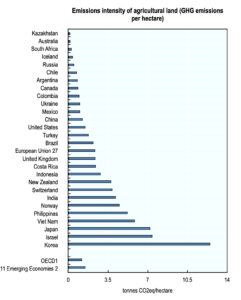Good Work
Ted Bilyea says the “worst case scenario” to manage emissions would be government restrictions that reduce agriculture productivity in Canada. Global demand for vegetable oil, for example, is not going down, so if Canada produces less “this would shift production to more damaging parts of the world,” says the chair of the Canadian Agri-food Policy Institute.

When it comes to agriculture emissions, Canada ranks fairly well in OECD comparisons. In its Agriculture Policy and Monitoring Evaluation 2022, OECD shows greenhouse gas (GHG) emissions for 54 leading economies, including the EU bloc. For GHG emissions per hectare of agricultural land, Canada is among the best at 0.87 tonnes of CO2 equivalent per hectare. Australia, notably, is second best with only 0.18 tonnes per hectare. Australia has 400 million hectares of agriculture land, most of it outback cattle ranches with low stocking rates. Canada has around 70 million. While Australian edges Canada in total GHG emissions, its per-hectare emissions are very low.
This underlines a problem with GHG emission statistics. The message changes depending on how you present the numbers. “When emissions measurement is by value, Canada doesn’t look as good,” Bilyea says, and he’s right. For GHG emissions per US$ of agriculture production, Canada is middle of the pack.
South Korea’s numbers are particularly vulnerable to the twist factor. The country produces less than half the total GHG emissions that Canada does, but it has only 1.7 million hectares of agricultural land. Korea is by far the worst for emissions per hectare but fourth best for emissions per US$ of production. Korea is either awful or fantastic depending on which number you choose. Canada is great or good.
“Over the past couple of decades, Canada doubled output production and barely moved the dial on carbon emission,” Bilyea says. “Virtually no one is giving us credit for this.” The OECD is. Its 2022 report includes a section on Canada, which says Canada’s GHG emissions, after peaking in 2005, have stabilized. However, it adds, “this trend was mostly driven by a drop in emissions from livestock production, resulting from a reduced beef cattle population, largely offset by an increase in crop production, due to greater use of inorganic nitrogen fertilizers.”
“Over the past couple of decades, Canada doubled output
production and barely moved the dial on carbon emission.”
— Ted Bilyea
The message: Canada is doing well, but it can improve on nitrogen emissions.
This is true globally. “For many crops, the largest source of emissions is nitrous oxide related to the use of synthetic or organic fertilizers,” reads the opening section of the OECD report. It specified advances in precision agriculture and the use of nitrification and urease inhibitors to reduce emissions while maintaining or increasing productivity. The OECD then made this important statement: “Increasing agricultural productivity and yields is key to reducing the need for additional land to meet food demand.”
Practices to improve nitrogen efficiency are defined in 4R practices, and adoption of basic 4R practices is fairly widespread in Canada. Advanced 4R, including enhanced efficiency fertilizer and variable rate, which could further reduce emissions and increase productivity, is coming along. The Canola 4R Advantage program provides incentives to adopt these practices.
Earlier this summer I tagged along on Manitoba Canola Growers’ Research Camp, which took agriculture researchers on a bus tour to visit six farmers across the province. These farmers are doing exactly what Canadian agriculture needs to improve productivity, reduce emissions and demonstrate to the world that Canadian farmers care. On the tour I met farmers integrating livestock to provide organic fertilizer and include perennial forages in the crop rotation, using spring-only nitrogen banding to reduce losses, planting shelterbelts between fields and permanent grass in high erosion areas, and using technology to protect yield and reduce pesticide rates.
The world needs to encourage farmers like this who will produce more from the same land base, waste less and do their part for the planet.




